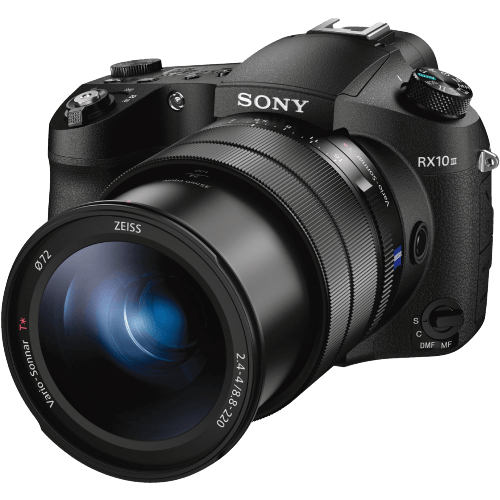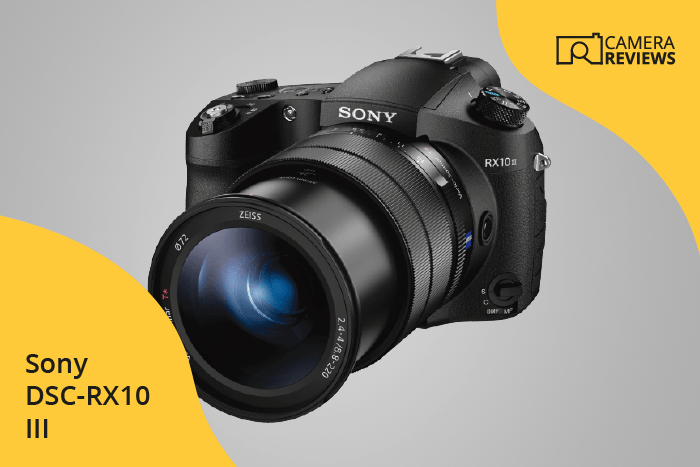Sony Cyber-shot DSC-RX10 III Specs and Scores

The Sony Cyber-shot DSC-RX10 III receives a score of 63/100 in our evaluation. Announced on March 29, 2016, this bridge camera hit the market at a price of $1499. With dimensions of 133 x 94 x 127mm and a weight of 1051g (2.32lbs), the camera offers a solid build quality. Although it was released in 2016, the specifications of the DSC-RX10 III still hold up well in today’s market, providing a reliable option for photography enthusiasts.
Sony Cyber-shot DSC-RX10 III Overview and Optics
The Sony Cyber-shot DSC-RX10 III receives an optics score of 63/100. This camera features a 20-megapixel CMOS sensor with a 1″ size and Bionz X processor. The sensor has a DXOMARK score of 70, and the camera has a shooting speed of 14 frames per second. The aspect ratio is 3:2, and it offers image stabilization.
In the current market, the DSC-RX10 III’s optics are competitive, but not exceptional. The 20-megapixel sensor provides adequate resolution, and the 1″ sensor size is standard for this type of camera. The fixed lens mount may limit versatility for some users, but the image stabilization is a valuable feature.
Considering these specifications, the Sony Cyber-shot DSC-RX10 III is a solid choice for those seeking a capable camera with reliable optics. However, it may not be the top option for users seeking cutting-edge performance or interchangeable lenses.
Sony Cyber-shot DSC-RX10 III Video Performance
The Sony Cyber-shot DSC-RX10 III receives a video score of 64 out of 100. This camera offers Full HD video resolution with maximum dimensions of 1920 x 1080 pixels. The maximum video frame rate is 120fps, providing smooth and detailed footage.
However, in today’s market, many cameras offer 4K video resolution, which is superior to the Full HD offered by the DSC-RX10 III. Furthermore, this camera lacks built-in time-lapse functionality, which is a popular feature among modern cameras.
Taking these factors into account, the Sony Cyber-shot DSC-RX10 III has decent video capabilities but falls short when compared to some of the latest camera models with more advanced video features.
Sony Cyber-shot DSC-RX10 III Features and Benefits
The Sony Cyber-shot DSC-RX10 III receives a feature score of 70/100. This camera boasts a 3-inch touchscreen with a screen resolution of 1,228,800 dots, providing clear image previews and convenient control. The flip screen enhances the user experience, allowing for versatile shooting angles and selfie opportunities.
However, the camera lacks GPS functionality, limiting its appeal to travel photographers who may wish to geotag their images. The RX10 III does include Wi-Fi capabilities, enabling easy sharing and remote control via a smartphone. Bluetooth is absent, but this omission does not significantly impact the overall functionality.
The features of the Sony Cyber-shot DSC-RX10 III prove competitive in today’s market, despite some minor shortcomings. The combination of a high-resolution touchscreen, flip screen, and Wi-Fi connectivity make it a strong contender for those seeking a versatile and user-friendly camera.
Sony Cyber-shot DSC-RX10 III Storage and Battery
The Sony Cyber-shot DSC-RX10 III receives a storage and battery score of 24/100. It comes with a single memory card slot compatible with SD, SDHC, SDXC, Memory Stick Duo, Pro Duo, and Pro-HG Duo cards. The camera’s battery life provides 420 shots with the NP-FW50 battery type. However, it lacks USB charging capabilities.
Compared to other cameras in today’s market, the DSC-RX10 III’s storage and battery specifications are quite basic. The single memory card slot and limited battery life may not be sufficient for professional photographers or those who require extended shooting periods. The absence of USB charging also limits convenience and flexibility in power management.
Sony Cyber-shot DSC-RX10 III Alternatives
Do you want to know how the Sony Cyber-shot DSC-RX10 III compares to its competitors? Have a look at the most popular comparisons for this camera below:
- Sony Cyber-shot DSC-RX10 III vs Cyber-shot RX10 IV
- Panasonic Lumix DMC-FZ2000 / FZ2500 vs Sony Cyber-shot DSC-RX10 III
- Panasonic Lumix FZ300 / FZ330 vs Sony Cyber-shot DSC-RX10 III
- Nikon Coolpix P1000 vs Sony Cyber-shot DSC-RX10 III
- Canon PowerShot SX70 HS vs Sony Cyber-shot DSC-RX10 III
- Nikon Coolpix P950 vs Sony Cyber-shot DSC-RX10 III
Sony Cyber-shot DSC-RX10 III FAQ
Does the Sony Cyber-shot DSC-RX10 III Have Built-in Image Stabilization?
Yes, the Sony Cyber-shot DSC-RX10 III features built-in Optical SteadyShot image stabilization, which helps to reduce camera shake and produce sharper images in various shooting conditions.
Does the Sony Cyber-shot DSC-RX10 III Support 4K Video Recording?
Actually, the Sony Cyber-shot DSC-RX10 III does support 4K video recording at 30fps, providing high-quality video footage with impressive detail and clarity.
What Size Sensor Does The Sony Cyber-shot DSC-RX10 III Have?
The Sony Cyber-shot DSC-RX10 III is equipped with a 1-inch Exmor RS CMOS sensor, which offers excellent image quality and low-light performance.
Does the Sony Cyber-shot DSC-RX10 III Have a Dual Memory Card Slot?
No, the Sony Cyber-shot DSC-RX10 III has a single memory card slot, supporting SD, SDHC, and SDXC cards for storage.
Does the Sony Cyber-shot DSC-RX10 III Have a Touch Screen?
Yes, the Sony Cyber-shot DSC-RX10 III features a 3-inch tilting touchscreen LCD, allowing for easy navigation and control of the camera’s settings.
Does the Sony Cyber-shot DSC-RX10 III Have Wi-Fi and Bluetooth?
The Sony Cyber-shot DSC-RX10 III has built-in Wi-Fi for wireless image transfer and remote control capabilities. However, it does not have Bluetooth connectivity.
Does the Sony Cyber-shot DSC-RX10 III Have GPS?
No, the Sony Cyber-shot DSC-RX10 III does not have built-in GPS functionality for geotagging photos.
Is the Sony Cyber-shot DSC-RX10 III Weather Sealed?
Yes, the Sony Cyber-shot DSC-RX10 III features a weather-sealed design, making it resistant to dust and moisture for reliable performance in various environments.
Does the Sony Cyber-shot DSC-RX10 III Have a Built-in Flash?
Yes, the Sony Cyber-shot DSC-RX10 III includes a built-in pop-up flash for additional lighting when needed, especially in low-light situations.

